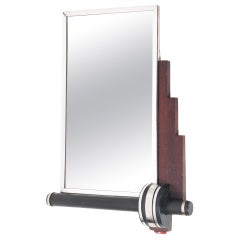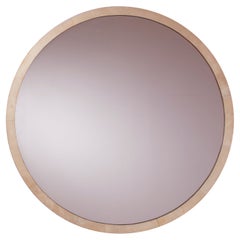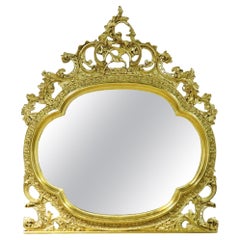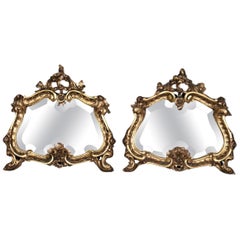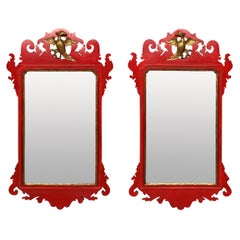Walnut Wall Mirrors
10
to
6
4
10
10
10
4
1
62
105
353
136
64
216
49
14
5
7
10
21
39
78
37
4
3
Height
to
Width
to
38,025
191
159
146
98
10
3
2
2
2
1
1
Period: 1930s
Material: Walnut
French Walnut Art Deco Wall Mirror, 1930s
Located in Amsterdam, NL
Stunning and elegant Art Deco petite wall mirror.
Striking French design from the 1930s.
Original walnut and nickel-plated brass frame with original black
lacquered lining.
The mirro...
Category
1930s French Art Deco Vintage Walnut Wall Mirrors
Materials
Nickel
Paolo Buffa for Serafino Arrighi Rare Walnut Radicca Mirror, Italy, 1930s
By Paolo Buffa
Located in New York, NY
Paolo Buffa designed and executed by cabinetmaker Serafino Arrighi rare walnut radica mirror, Italy, 1930s. This exquisite hand-crafted artisan mirror i...
Category
1930s Italian Art Deco Vintage Walnut Wall Mirrors
Materials
Walnut
Gio Ponti walnut and parchment mirror, Italy, 1930s
By Gio Ponti
Located in Chiavari, Liguria
Mirror in American walnut and parchment, Gio Ponti design, 1930s, Italian production. A perfect geometric circle in walnut finished in parchment with a natural and evocative flavor. ...
Category
1930s Italian Vintage Walnut Wall Mirrors
Materials
Walnut, Parchment Paper
Monumental Gilded French Louis XV Carved Mantel Buffet Wall Mirror
Located in Swedesboro, NJ
This is a spectacular Monumental mirror of serious size and in beautiful gold leaf done in the best possible way. The gold os beautiful and reflective wich elaborate carving. Carved ...
Category
1930s French Louis XV Vintage Walnut Wall Mirrors
Materials
Walnut
Swedish Designer, Wall Mirror, Walnut, Sweden, 1930s
Located in High Point, NC
A walnut wall mirror designed and produced in Sweden, c. 1930s.
Category
1930s Swedish Vintage Walnut Wall Mirrors
Materials
Walnut
Pair of Small Beveled Italian Rococo Gilded Mirrors
Located in Swedesboro, NJ
This is a gorgeous pair of small beveled glass gilded wooden Rococo mirror. The pair of mirrors is in good condition with minor signs of age and use such...
Category
1930s Italian Rococo Revival Vintage Walnut Wall Mirrors
Materials
Walnut
Red Lacquered Queen Anne Style Mirror
Located in London, GB
An English Queen Anne style red lacquered slender mirror, which makes up a matched pair with a seperate listing.
Category
1930s English Queen Anne Vintage Walnut Wall Mirrors
Materials
Walnut
Red Lacquered Queen Anne Style Mirror
Located in London, GB
An English Queen Anne style red lacquered slender mirror, which makes up a matched pair with a seperate listing.
Category
1930s English Queen Anne Vintage Walnut Wall Mirrors
Materials
Walnut
Large Art Deco Mirror, Walnut and Mahogany Frame, Antique Glass, Sweden 1930s.
Located in Copenhagen, DK
Large Art Deco mirror with fine detailed antique frame in walnut and mahogany.
Beautiful antique facetted glass, Sweden 1930s.
The mirror has a beaut...
Category
1930s Swedish Art Deco Vintage Walnut Wall Mirrors
Materials
Walnut, Mahogany, Mirror
1930s Large Art Deco Round Mirror, Stained Walnut, Spain - Barcelona
Located in Girona, ES
Large Art Deco round mirror with stained walnut frame, French polish.
Spain, Barcelona, circa 1930.
Category
1930s Spanish Art Deco Vintage Walnut Wall Mirrors
Materials
Mirror, Walnut
Related Items
1930s Art Deco Brass and Etched Glass Hexagonal Italian Wall Mirror
By Gio Ponti
Located in Aci Castello, IT
This Italian Wall Mirror exemplifies the opulence, sophistication, and geometric elegance characteristic of the Art Deco movement. It's in original condition with signs of use and ag...
Category
Mid-20th Century Italian Art Deco Walnut Wall Mirrors
Materials
Brass
Gio Ponti Medium Randaccio Mirror
Located in Glendale, CA
Gio Ponti medium Randaccio mirror. Executed in brass and glass. Ponti created the Randaccio Mirror in 1925 for his home on Via Randaccio in Milan. Cha...
Category
21st Century and Contemporary Danish Mid-Century Modern Walnut Wall Mirrors
Materials
Brass
Mid-Century Italian Rectangular Minimal Mirror in Brass Gio Ponti Style
By Gio Ponti
Located in Palermo, Sicily
Italian Rectangular Minimal Mirror from the middle of the century in Gio Ponti brass Attributed, the lateral cone in solid brass structure in wood, orig...
Category
1950s Italian Mid-Century Modern Vintage Walnut Wall Mirrors
Materials
Brass
H 59.06 in W 12.8 in D 1.19 in
Pair of Italian Giltwood Neoclassical Beveled Mirrors
Located in West Palm Beach, FL
Pair of Italian Giltwood Neoclassical Beveled Mirrors
Italy, circa 1960s
A hard to find Pair of vintage Italian Giltwood Neoclassical Beveled Mirrors originating from Italy in the 1960s. Each mirror, measuring 33 inches in height by 26 inches in width, boasts an alluring octagonal form with a continuous stylized carved giltwood rope and acanthus motif, encapsulating timeless beauty and classical motifs.
The mirrors features eight individual 3-inch deep beveled mirrored octagonal...
Category
20th Century Italian Neoclassical Walnut Wall Mirrors
Materials
Mirror, Giltwood
Brass Framed Mirror in the Style of Gio Ponti, Italy, 1950's
By Gio Ponti
Located in Paris, Ile-de-France
Brass Framed mirror in the style of Gio Ponti
Curved edges.
Italy, circa 1950.
Dimensions, Measures:
Hauteur / Height : 90 cm / 35.4 inch
Largeur en haut / Width at the t...
Category
1950s Italian Mid-Century Modern Vintage Walnut Wall Mirrors
Materials
Brass
Gio Ponti Large Randaccio Mirror
Located in Glendale, CA
Gio Ponti large Randaccio mirror. Executed in brass and glass. Ponti created the Randaccio Mirror in 1925 for his home on Via Randaccio in Milan. Char...
Category
21st Century and Contemporary Danish Mid-Century Modern Walnut Wall Mirrors
Materials
Brass
French Art Deco Wall Mirror Wrought Iron, circa 1930
Located in Labrit, Landes
Art Déco wall mirror,
Wrought iron and beveled mirror.
The mirror frame represents flowers and leaves.
Good antique condition.
Shipping:
P 3 L 77.5 H 42 cm 4.8 Kg.
Category
1930s French Art Deco Vintage Walnut Wall Mirrors
Materials
Wrought Iron
Gio Ponti Small Randaccio Mirror
Located in Glendale, CA
Gio Ponti small Randaccio mirror. Executed in brass and glass. Ponti created the Randaccio Mirror in 1925 for his home on Via Randacci...
Category
21st Century and Contemporary Danish Mid-Century Modern Walnut Wall Mirrors
Materials
Brass
Gio Ponti Mirror
By Gio Ponti
Located in MADRID, ES
Original mirror by Gio Ponti with bronze frame and solid wood back.
Giovanni Ponti, better known as Gio Ponti (Milan, 18 November 1891 - idem, 16 September 1979) was one of the mos...
Category
1950s Italian Mid-Century Modern Vintage Walnut Wall Mirrors
Materials
Bronze
Beautiful extraordinary 1930s Art Deco wall mirror made of oak
Located in München, DE
Beautiful artful 1930s wall mirror made of dark oak wood.
Great Art Deco design from the 30s. Made in Germany.
Very elaborately manufactured with the graphic motifs on the frame.
Ver...
Category
1930s German Art Deco Vintage Walnut Wall Mirrors
Materials
Mirror, Oak
Rococo Revival Parcel Gilded Mirror
Located in New York, NY
Rococo Revival parcel gilded mirror with reticulated rocaille crested cornice above scrolling and molded frame, centering a horizontal mirror plate.
Category
20th Century French Rococo Revival Walnut Wall Mirrors
Materials
Giltwood
HENRY LINK Margaux Collection Cherry French Country Louis XV Wall Mirror
By Henry Link
Located in Charlotte, NC
A French Country Louis XV style wall mirror by Henry Link, part of Lexington Furniture, from their Margaux Collection. Mirrored glass in a cherry wood frame with an arched top and de...
Category
Late 20th Century American Louis XV Walnut Wall Mirrors
Materials
Mirror, Cherry
Previously Available Items
Pair Of English George II Style Scarlet Lacquered Mirrors
Located in London, GB
A pair of English George II style mirrors in scarlet lacquer, parcel gilded and with hand bevelled plates.
Category
1930s English George II Vintage Walnut Wall Mirrors
Materials
Mirror, Walnut, Giltwood
Antique French Mirror Carved Walnut Framed Wall Mirror Shell Lattice Accent 1930
Located in Tyler, TX
CHARMING Antique French Shell and Lattice Framed Carved Walnut Wall Mirror~~c. 1930s
Popular classic French oak mirror with shell and lattice ...
Category
1930s French Renaissance Revival Vintage Walnut Wall Mirrors
Materials
Walnut, Mirror
H 33 in W 20.5 in D 1 in
Beautiful, Unusual Italian Mid Century Wall Mirror Made of Walnut Wood
Located in München, DE
Beautiful fancy wall mirror made of walnut wood.
Great Italian design from the 30' - 40's.
Very elaborately manufactured with graphical motifs on the frame.
Very good vintage cond...
Category
1930s Italian Mid-Century Modern Vintage Walnut Wall Mirrors
Materials
Mirror, Walnut
H 22.45 in W 20.08 in D 0.79 in
Italian Wood & Glass 1930-40s Wall Mirror in the Shape of a Painter's Palette
Located in Varese, Lombardia
Small wall mirror made of walnut & mirrored glass in the shape of a painter's palette.
The glass is ground and shows some oxidation spots as displayed in the pictures.
Category
1930s Italian Art Deco Vintage Walnut Wall Mirrors
Materials
Brass
H 19.69 in W 14.57 in D 0.6 in
1930s George II Style Walnut and Parcel-Gilt Mirror
Located in London, GB
An English George II style carved walnut and gilded mirror.
Category
1930s English George II Vintage Walnut Wall Mirrors
Materials
Walnut
French Art Deco Octagonal Walnut Mirror with Beveled Mirror & Gilt Detailing
Located in New York, NY
This stunning Art Deco mirror mirror was realized in France circa 1930. It features an octagonal form in walnut wiht a plain beveled mirror in the center. The mirror hangs from a jav...
Category
1930s French Art Deco Vintage Walnut Wall Mirrors
Materials
Walnut, Giltwood
H 41.25 in W 32.5 in D 2.5 in
Antique French Neoclassical Walnut and Satinwood Mirror
Located in London, GB
A stunning large vintage mirror in the antique French style, this dates from circa 1930s period.
It is of amazing quality, the frame i...
Category
1930s French Neoclassical Vintage Walnut Wall Mirrors
Materials
Satinwood, Walnut
Art Deco Wall Mirror, High Gloss Black Lacquer, France, circa 1930
Located in Regensburg, DE
Elegant, broad Art Deco wall mirror from France, circa 1930
High-gloss black lacquer on walnut wood. Old mirror glass. Wire on the backside for hanging
Dimensions: H 42.5 cm x ...
Category
1930s French Art Deco Vintage Walnut Wall Mirrors
Materials
Mirror, Walnut, Lacquer
Art Deco Wardrobe, Black Lacquer, Silver Plate and Nickel, France, circa 1930
Located in Regensburg, DE
Outstanding, big and original Art Deco wardrobe with mirror from France, circa 1930.
Excellently restored condition. Glossy piano varnish finish in a deep black.
Silver plated leave...
Category
1930s French Art Deco Vintage Walnut Wall Mirrors
Materials
Silver Plate, Nickel, Metal
H 82.68 in W 55.12 in D 12.41 in
Erik Chambert Walnut Mirror, Swedish Modern, 1930s
Located in Skanninge, SE
Unusual mirror by Erik Chambert for Chamberts Möbelfabrik in Norrköping.
Really good quality and perfect condition.
Erik Chambert (1902-1988) was one of the first interior designers to graduate from Högre Konstindustriella Skolan (now the University College of Arts, Crafts, and Design, Konstfack) in 1925. Before that, he had been awarded a silver medal for his apprentice piece in cabinet-making. He and his brother, the master cabinet-maker Otto, ran the family furniture-making business AB Chamberts Möbelfabrik in Norrköping, with Erik as the artistic director. The company had been founded in 1883 by their father, Axel Chambert.
As an interior designer, Erik Chambert’s first major assignment was for the Stockholm Exhibition in 1930, where he designed the functionalist interior for an apartment by the recently-appointed municipal architect of Norrköping, Kurt von Schmalensee. Gotthard Johansson expressed his opinion on Chambert’s participation in the daily paper Svenska Dagbladet: “where simplicity has not become indigent, nor functionalism dogmatic”. The senior curator for the Stockholm Exhibition, Gregor Paulsson, commented on the apartment in an appreciative letter to Erik Chambert: “As for my personal opinion, I would like to say unconditionally that I consider it to be the biggest success of the entire exhibition. It is in keeping with the spirit we wished to achieve.”
Erik Chambert designed practical, comfortable and timeless furniture in a functionalist style that gave a blond, sober impression. Helena Dahlbäck Lutteman has called the style “humane functionalism”. Study trips around Europe after his graduation acquainted Erik Chambert with the Bauhaus school and Art Concrete. He was influenced by contemporary trends but reformulated what he saw and experienced in his style. For the Stockholm Exhibition, he designed a folding recliner with light wood construction and red varnished armrests in steel. This was the only time he used this particular material that was fashionable during that period. Källemo AB in Värnamo began making replicas of the recliner and other classics by Erik Chambert in recent decades. One of these new recliners is currently standing in the library of Arkitektur- och designcentrum (earlier Arkitekturmuseet) in Stockholm. Erik Chambert believed that a piece of furniture should be functional and blend with the surroundings. A work desk with a reversible pine top, one side for work and the other for more festive occasions, with a shelf construction of wood slats underneath for paper and drawings, was shown at an exhibition in Zurich in 1949. Usually, his designs were only produced in one or very few copies. The chair “Poem” from 1953 is a rare exception.
The year before he died, Erik Chambert said, “Exhibitions have been my life.” As a furniture designer, he participated in numerous prestigious international exhibitions together with AB Chamberts Möbelfabrik: Chicago in 1933, the world fairs in Brussels and Paris in 1935 and 1937 respectively, the international crafts exhibition in Berlin in 1938 and the world exhibition in New York in 1939.
Erik Chambert gave vent to his visual creativity when he designed furniture. This is evident, for instance, in the rich marquetry he made to order or for exhibitions. He took a delight in creating entire pictures, not just patterns, in marquetry, depicting figures or cityscapes in different woods. He often combined these with shimmering mother of pearl and metals. In 1945, he designed the cabinet “The Scales of Life”, now in the Nationalmuseum collection. The marquetry inlayer was Manne Manning. The cabinet was based on an eponymously titled gouache from 1943.
As an interior designer, Erik Chambert was frequently commissioned for public spaces and private homes. Most assignments were from institutions and private companies in and around Norrköping, but his clients also included Haga Palace and the Tessin Palace, through the National Board of Public Buildings. In addition to suggesting furniture and textiles, he was involved in deciding the color schemes for walls, designing fabrics, sometimes for specific purposes, composing tapestries and a few larger curtains with appliqué work. In the book “Svenska Textilier 1890-1990” (Swedish Textiles 1890-1990), Anne-Marie Ericsson writes, “An interesting example is the furniture designer Erik Chambert, who allowed both his disciplines, as an artist and a designer, to merge in his rhythmically distinct patterns for textile prints.” Erik Chambert collaborated with Jobs Handtryck and Tabergs Yllefabrik, among others. A textile with stylized Norrköping scenes for the foyer walls of the municipal theatre in Norrköping and also the textile ”Skyttlarna” was recently revived and put into production by Stadsmuseet in Norrköping. The museum also has the Chambert company’s archives in its collection.
In the 1920s and 1930s, Erik Chambert made many exquisite watercolored sketches of furniture set in their imagined context in the furnishing of a room. As studies for cabinet embellishments, wall paintings, and wallpaper he painted grass and flowers. Towards the end of the 1930s, the gouaches developed and began to feature figurative elements and organic non-figurative billowing forms. In 1943, Erik Chambert made his debut at the Liljevalchs autumn exhibition. He was subsequently represented in several exhibitions at Liljevalchs. In the 1950s, Erik Chambert painted abstracts which he initially called Compositions, followed by a number of capital letters. Bo Sylvan writes that Erik Chambert’s paintings tended towards “geometrically pruned shapes and a fastidious palette”. Up until 1959, Erik Chambert painted in gouache, but in 1960 he went over to oils.
In the mid-1960s, Erik Chambert abandoned his flat compositions and began creating reliefs in white, black or red paper or silver paper and gold foil, in a striving to achieve tension with a spatial effect. The viewer was encouraged to move in front of the work to perceive how light and shade enhanced the impression. The reliefs were built into boxes of Plexiglas, which were part of the work of art. “Lady with Dog” is an early example of this technique. The work was produced in 100 identical copies. It was included in the art society Konstfrämjandet’s exhibition “Multikonst” (Multi-Art) which was shown at 100 venues throughout Sweden simultaneously in 1967.
Erik Chambert has been regarded as a Concretist but, as Staffan Carlén points out in the foreword to the catalog to the solo exhibition at Millesgården in 1990, “Erik Chambert did not want to label his works as Concrete, and it would therefore perhaps be more Apt to speak of geometric abstraction.” His works were nearly always based on an experience or impression, such as thoughts on life, as in “The Scales of Life”, the triptych “Life Cycle” from 1963, now in Norrköpings konstmuseum, or series I-X from “A Life” or other pictures from the same, often made in connection with annual summer trips to European destinations, for instance “Les Halles” (1965), “Pointe du Raz” (1967) or “Gibraltar” (1980).
In the late 1960s, throughout the 1970s and in the early 1980s, Erik Chambert pursued his exploration of light and refraction, using only Plexiglas sheets and rods, occasionally with additions of paint to enhance the motif. In his speech at the opening of the exhibition at Millesgården, Bo Sylvan called the crystal-clear Plexiglas relief sculptures from the early 1980s “light organs”. All the Plexiglas works with their accompanying boxes were sawn, honed and joined by hand with aesthetic ingenuity. As a young cabinetmaker’s apprentice, he had learned to handle wood with great skill. Likewise, the mature artist used his inventiveness and craftsmanship to find technical solutions when working with Plexiglas. All the boxes are square, the largest measuring 1×1 meter. Erik Chambert enjoyed the Challenge of achieving expansive tensions in a square.
Otto G. Carlsund and Gösta Adrian Nilsson...
Category
1930s Swedish Scandinavian Modern Vintage Walnut Wall Mirrors
Materials
Glass, Walnut
Art Deco Walnut Veneer Mirror
Located in Porto, PT
Art Deco walnut veneer wall mirror.
Category
1930s French Art Deco Vintage Walnut Wall Mirrors
Materials
Mirror, Walnut
Art Deco Mirror, Walnut Veneer, France, circa 1930
Located in Regensburg, DE
Wonderful original Art Deco Mirror from France, circa 1930.
The frame is solid and veneered walnut with a nice grain and hand-polished with shellac. The mirror glass is still the or...
Category
1930s French Art Deco Vintage Walnut Wall Mirrors
Materials
Mirror, Walnut
Recently Viewed
View AllMore Ways To Browse
Antique Mirror 1930s
Retro Distressed Mirror
Large Matching Mirrors
French Riviera Bamboo
1940s Venetian Mirror
Round Wooden Mirror
Pair Louis Xvi Mirrors
Italian Arch Mirror
Gilted Wall Garland
Plaster Framed Mirror
Large Round Wood Mirror
Deco Etched Mirror
Modern Danish Wood Mirror
Venetian Mirror With Flowers
Brass Silver Wall Mirror
Gold Frame Leaves Mirror
Hollywood Regency Gilt Wood Mirror
Antique Solid Wood Mirror
